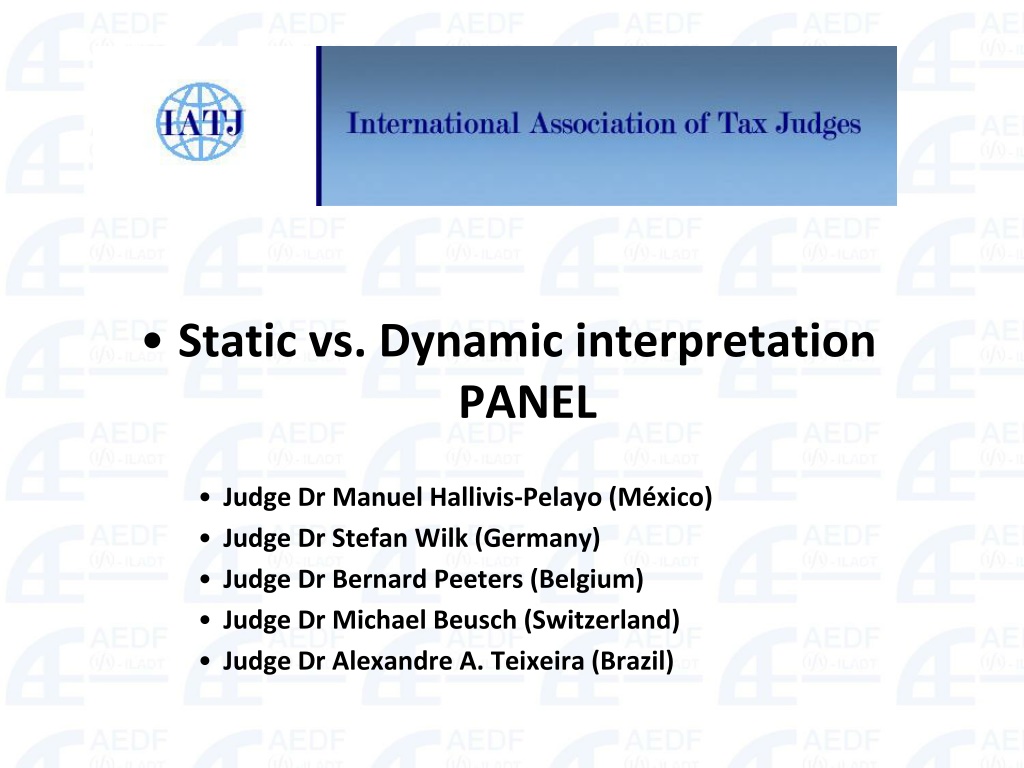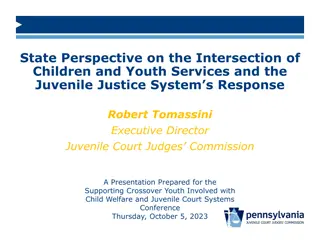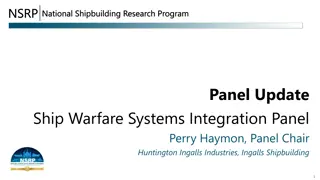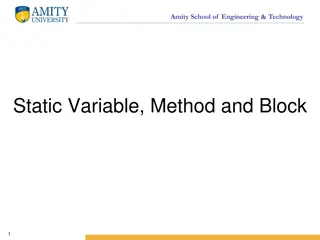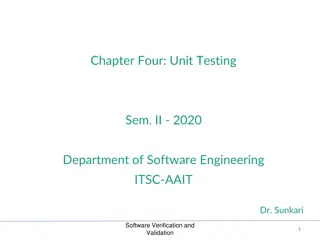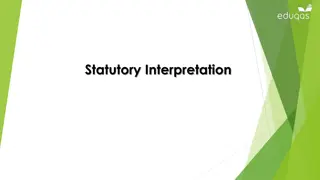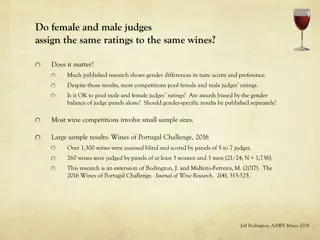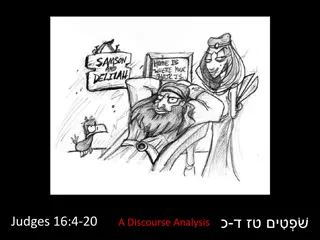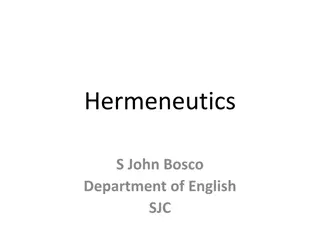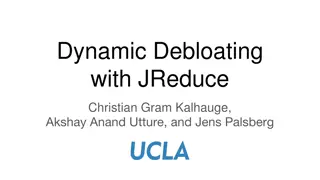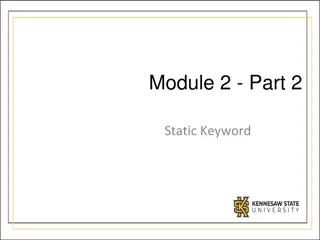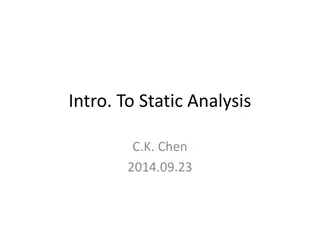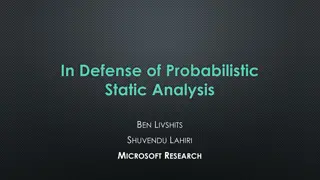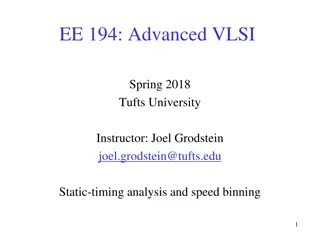Static vs. Dynamic Interpretation Panel Discussion by International Judges
A panel discussion featuring judges from Mexico, Germany, Belgium, Switzerland, and Brazil on the topic of static vs. dynamic interpretation in legal cases. The discussion covers key issues, case studies, and outcomes. Legal sources like VCLT and OECD MC are referenced, emphasizing the importance of interpreting treaty terms in good faith. The panel highlights the role of commentaries in international fiscal law development and dispute resolution.
- Panel Discussion
- Static vs. Dynamic Interpretation
- International Judges
- Legal Sources
- Treaty Interpretation
Download Presentation

Please find below an Image/Link to download the presentation.
The content on the website is provided AS IS for your information and personal use only. It may not be sold, licensed, or shared on other websites without obtaining consent from the author. Download presentation by click this link. If you encounter any issues during the download, it is possible that the publisher has removed the file from their server.
E N D
Presentation Transcript
Static vs. Dynamic interpretation PANEL Judge Dr Manuel Hallivis-Pelayo (M xico) Judge Dr Stefan Wilk (Germany) Judge Dr Bernard Peeters (Belgium) Judge Dr Michael Beusch (Switzerland) Judge Dr Alexandre A. Teixeira (Brazil)
Content 1. 2. 3. 4. 5. 6. 7. 8. Introduction. Basic problem. Background. Legal sources. Key issues. Case studies. Outcome of the cases. Conclusions. 2
The Basic Problem Static vs. Dynamic Interpretation Use of previous or latter Commentaries by Courts? 3
Legal Sources VCLT (General rules on treaty interpretation). Article 3(2) of the OECD MC. https://encrypted-tbn1.gstatic.com/images?q=tbn:ANd9GcSvZ8XeLst76Wn7xVg-umOeKXUYSSwXdvu5804ImdsPcJ0zlsGGBA 4
VCLT Vienna Convention on the Law of Treaties (Dr Engelen) Article 31(1): Treaty terms should be interpreted in good faith and in accordance with the ordinary meaning, in the light of the object and purpose of the treaty. Article 31(4): However, special meaning if it is established that the parties so intended. Article 31(2) and (3): The interpreter can have recourse to authentic expressions of intent by the Contracting States. Article 32: Supplementary means of interpretation can be permitted if the outcome is ambiguous, ambiguous obscure or manifestly absurd. 5
Introduction of the OECD MODEL 28. For each Article in the Convention, there is a detailed Commentary that is intended to illustrate or interpret its provisions. 29. As the Commentaries have been drafted and agreed upon by the experts appointed to the Committee on Fiscal Affairs by the Governments of member countries, they are of special importance in the development of international fiscal law. Although the Commentaries are not designed to be annexed in any manner to the conventions signed by member countries, which unlike the Model are legally binding international instruments, they can nevertheless be of great assistance in any manner to the conventions signed by member countries, which unlike the Model are legally binding international instruments, they can nevertheless be of great assistance in the application and interpretation of the conventions and, in particular, in the settlement of any disputes. 33. other changes or additions to the Commentaries are normally applicable to the interpretation and application of conventions concluded before their adoption, because they reflect the consensus of the OECD member countries as to the proper interpretation of existing provisions and their application to specific situations. 6
Static vs. Dynamic Approach Static interpretation or approach, means the use of the current commentaries at the time the DTC was concluded. Argument: These are the commentaries that the negotiators and their parliaments knew at the moment of negotiating and celebrating the Convention. They are the Commentaries taken into account by taxpayers to make their business decisions. On the contrary, the dynamic approach, also known as ambulatory or evolutionary, considers that, when applying a DTC, we should take into account the commentaries that are in use at the moment of applying such DTC. It is impossible to foresee all the different cases, and new additional topics could arise, so, fiscal authorities should comply with those commentaries that are in force even if they are periodically modified. 8
Arguments On one hand, some scholars are opposed basically because of legal certainty. Because CDT s are celebrated taking into account certain relevant social, political and economical circumstances prevailing at the moment of negotiating the treaty, and if later commentaries are issued, it will break the will expressed by the Countries at the moment of concluding the treaty. It is difficult to understand that the will of the Parties is carried out if the treaty entered into force before the revised Commentaries are issued. It lacks parliamentary legitimacy. On the other, part of doctrine and authorities encourage the use of the dynamic interpretation. OECD members (tax authorities) agree in changes, and consider that it is the will of member States. It is a form of updating Tax Treaties . It achieves the goal of tax evolution, according to changes in technology and trade. to dynamic approach 9
John Avery Jones There was originally little use made of the OECD Commentaries, but in 1981 they were relied on for the first time for confirmation of a view that the tribunal and court had already reached. Today it would be most unlikely that the Commentaries would not be referred to in a treaty case. The precise weight to be given to the Commentaries has not been discussed. In UBS my colleague and I would potentially have given considerable weight to them on the basis of Art. 31 (4) of the Vienna Convention ( A special meaning shall be given to a term if it is established that the parties so intended ) 10
Jan Wouters and Maarten Vidal From the beginning , Human Rights Treaties were intended to remain valid for an indeterminate, longer period of time. Both the International Court of Justice , which stated that an international instrument must be interpreted and applied within the entire legal system prevailing at the time of the interpretation and the European Court of Human Rights, which recalled that the Convention is a living instrument which must be interpreted in the light of present-day conditions There is no compelling reason why domestic judges cannot interpretation the evolutionary interpretation of treaties should not necessarily be confined to human rights conventions it can be extended to other legal instruments, multilateral laying down lasting basic rules concluded for a longer period of time, including double taxation agreements. resort to an evolutionary both bilateral and 11
Positions Lara Yaffar, if both parties are members of the OECD then there is a reasonable presumption that when adopting identical rules to the Model they had the intention of them to be interpreted in the same form as that established by the Commentaries in force at the moment of concluding the treaty Avery Jones: previous commentaries should only confirm an ambiguity so, the latters should be taken into account in order to prevail that interpretation frozen with time and fails in adapting and evolve along with changes in business and technology, specially software and electronic trade; in this way is more likely to obtain a common interpretation. Lang & Brugger .- Amendments to the OECD Model Convention and to the OECD Commentary made after the conclusion of a DTC have to be seen in a different light. Later Commentary amendments cannot serve to establish the parties intentions upon conclusion of a double taxation convention. Such amendments may only play a limited role in the interpretation of previously concluded DTC if recourse to other. 12
Positions David A. Ward: Later gap filling and reversing Commentaries should never be applied in interpreting earlier treaties. Therefore the problem of retroactivity should not arise if later Commentaries which are genuinely interpretive are given the weight in the same way as the opinions of respected commentators since the application of such Commentaries does not have the same retroactive effect of attempting to change bilateral tax treaties by subsequent gap-filling or reversing Commentary. Arnold &McIntyre: It is difficult to justify including the Commentary as part of the context of a treaty under Article 31 of the Vienna Convention, especially if the treaty being interpreted was entered into before the Commentary was revised or if one of the Contracting States is not a member of the OECD and therefore had no part in the preparation of the Commentary. Although the status of the OECD Model Treaty and Commentary under the Vienna Convention is a controversial topic among international tax scholars, the issue appears to be of little practical significance. In treaty cases from virtually all countries, the courts invariably give the Model Treaty and Commentary substantial weight. Engelen: Later changes or additions to the Commentaries are of no relevance for the purpose of interpreting or applying existing tax treaties where the provisions of the OECD Model Tax Convention, as paragraph 35 of the introduction to the Model suggests. They could be supplementary means of interpretation and as such, may be used for the purposes of Article 32. 13
Binding for Courts? Vogel: everyone who has ever worked with loose-leafs knows that their reliability has a tendency to decrease, very often after a few instalments The Commentaries are only binding on authorities, but no on taxpayers or on courts. Changes in Commentaries after the conclusion of a Tax Treaty cannot modify a Treaty or determine its interpretation. But, even then, they are still the opinion of high ranking experts, which is entitled to a very great weight. Justice Graham Hill: I would afford the same status to the commentary on a provision in a model convention as I would to the opinion of textbook writers. Both are informative, but neither is binding. But it would seem a difficult manner, absent any consensus of the contracting states, to regard a commentary after ratification in the same way as a commentary before, if only because the changed commentary was not taken into account by the parties to the treaty before adopting the particular provision. 14
Binding for Courts? S inz de Bujanda: Courts are not bound to follow political criteria and the rules for treaty interpretation are very similar to those of domestic law. Chico: It is accepted by doctrine that Commentaries have a greater value than that of a merely interpretative issue, specially when the Articles of the Model are equal or the same as those in the CDT. Becerra: The ambulatory approach may work only if the interpretation maintains the object and purpose of the treaty at the time of the treaty s negotiation and conclusion, which is the time when the expectations of the parties were or should have been well established. Sergio Andr Rocha: As elements of interpretation, the definition as to the version of the Commentaries that should be used is taken in the field of the argumentative process, and therefore the decision is casuistic. 15
Courts Ward: Courts have not shown a consistent position regarding the use of subsequent OECD Commentaries. USA Tax Court said subsequent commentary should not be used, as well did the United States Federal Claims Court because the subsequent statements could not reflect the understanding and the expectation of the negotiating parties at the time the treaty was negotiated. In Canada, The Supreme Court said the commentaries were part of the legal context and of high persuasive value but did not discuss whether later commentaries were part of the legal context and had such high persuasive value. Rohatgi: Courts in Germany, Australia, Austria, Belgium, Canada, Norway and the U.K. accept the dynamic approach. However, this is not accepted by many others, because they consider it as reversing of the Treaty itself. He suggests to use an static method for changes in the Commentaries that occur after a Treaty is concluded. 16
Mxico Mexican Supreme Court , has considered them as soft law They have high persuasive value. Not binding, but lower Courts have to argue when not using them. Federal Tax Court: Not binding. High persuasive value. Important aid for interpretation. They have rarely been used, referred to or quoted. 17
Key Issues Questions: Relevance for interpretation. What is the significance of the VCLT?. Weight of the Commentaries. Art. 31 (3)? or Art. 34? or, in limited cases, Art. 31 (4)?. Binding on Courts?. Discussion of this topic on Courts?. Outcome of the cases?. Is there a Methodology to apply Commentaries?. 18
The OECD Commentary and its Importance for the Interpretation of Double Taxation Treaties (Germany) Dr. Stefan Wilk Richter am Finanzgericht Federal Ministry of Justice and Consumer Protection, Berlin 19
A. Introductory remarks Negotiation and conclusion of double taxation treaties by the Federal Government Necessity of parliamentary ratification Purely domestic law and double taxation treaties as separate legal spheres 20
A. Introductory remarks Autonomous interpretation of double taxation treaties Focus on word-for-word interpretation (nations signatory to the treaty wish to enter into binding obligations only to the extent these are specified by the treaty s wording) 21
A. Introductory remarks Analysis of exact wording: general linguistic usage or ordinary meaning in keeping with the overall intent and context of the treaty s remaining provisions Wording of the text itself as the definitive benchmark for a correct understanding of a double taxation treaty 22
B. Importance of the OECD Commentary Impact of the OECD Commentary in general: Supplementary means of interpretation within the meaning of Article 32 of the Vienna Convention on the Law of Treaties; supports a finding reached through other means 23
B. Importance of the OECD Commentary Static approach by the Federal Finance Court: Subsequent revisions of the OECD Commentary can have no effect on the interpretation of any double taxation treaty negotiated prior to such statements 24
C. Recent developments Clause 3 of the Protocol to Germany s double taxation treaty with Hungary of 28 February 2011: The application and interpretation of Articles 5 und 7 of the present Treaty, and in particular disagreements, should refer to the OECD Commentary as it relates to Articles 5 and 7 of the current OECD Model Treaty. If said Commentary is revised in future by the OECD, then Articles 5 and 7 of the present Treaty are to be interpreted in accordance with the revised OECD Commentary, provided that this is in keeping with the text of the Treaty. the settlement of 25
D. Summary Standard practice: Autonomous word-for-word interpretation; OECD Commentary as a supplementary means of interpretation no outsourcing of binding interpretation to the OECD 26
E. Recent decisions BFH of 9 June 2010 I R 94/09, BFHE 230, 321, BStBl. II 2011, 860 and of 9 December 2010 I R 49/09, BFHE 232, 145, BStBl. II 2011, 482 (OECD Commentary as an explanatory/corroborating source) BFH of 25 May 2011 I R 95/10, BFHE 234, 63 (OECD Partnership Report) BFH of 12 October 2011 I R 15/11, BFHE 235, 401, BStBl. II 2012, 548 (effect of incorporation of the OECD Model Treaty into the treaty without change) BFH of 16 January 2014 I R 30/12, BFHE 244, 354 (with further references to the static approach; wording as benchmark ) 27
Art. 3 2 OECD-model : static or dynamic interpretation? IATJ 5th Assembly Washington October 23, 2014 Bernard PEETERS Belgium 29
Art. 3 2 OECD Model Art. 3 2 OECD-Model : As regards the application of the convention at any time by a Contracting State, any term not defined therein shall, unless the context otherwise requires, have the meaning that it has at that time under the law of that State for the purposes of the taxes to which the Convention applies, any meaning under the applicable tax laws of that State prevailing over a meaning given to the term under other laws of that State. 30
Art. 3 2 OECD Commentary on art. 3 11. This paragraph provides a general rule of interpretation for terms used in the Convention but not defined therein. However, the question arises which legislation must be referred to in order to determine the meaning of terms not defined in the Convention, the choice being between the legislation in force when the Convention was signed or that in force when the Convention is being applied, i.e. when the tax is imposed. The Committee on Fiscal Affairs concluded that the latter interpretation should prevail, and in 1995 amended the Model to make this point explicitly. 31
Art. 3 2 OECD Commentary on art. 3 12. However, paragraph 2 specifies that this applies only if the context does not require an alternative interpretation. The context is determined in particular by the intention of the Contracting States when signing the Convention as well as the meaning given to the term in question in the legislation of the other Contracting State (an implicit reference to the principle of reciprocity on which the Convention is based). The wording of the Article therefore allows the competent authorities some leeway. 32
Art. 3 2 Commentary on art. 3 13. Consequently, the wording of paragraph2 provides a satisfactory balance between, on the one hand, the need to ensure the permanency of commitments entered into by States when signing a convention (since a State should not be allowed to make a convention partially inoperative by amending afterwards in its domestic law the scope of terms not defined in the Convention) and, on the other hand, the need to be able to apply the Convention in a convenient and practical way over time (the need to refer to outdated concepts should be avoided). 33
Art. 3 2 OECD-model : static vs. dynamic 11 of the OECD Commentary on art. 3 was added in the Commentary in 1992 ; The words at any time and at that time were added to the model in 1995; The reason for such a modification was the 1982 decision of the Canadian Supreme Court The Queen vs. Melford Developments Inc. (1982 2 SCR 504) (see J. Sasseville, Temporal aspects of tax treaties in Ph. Baker & C. Bobbett, eds., Tax Polymath : A life in International Taxation, Essays in honour of John F. Avery Jones, IBFD, 2010). 34
Art. 3 2 OECD-model : static vs. dynamic The Court disregarded a subsequent change in Canadian domestic tax law according to which a guarantee fee paid by a Canadian resident to a German bank should be considered as an interest payment subject to withholding tax. It decided that even though the treaty included a provision similar to Art. 3(2) (in its pre-1995 OECD version), that provision should be interpreted as a reference to the definition of interest under Canadian law at the time the Canadian Parliament adopted the Canada-Germany treaty and did not allow the application, for purposes of that treaty provision, of the 1974 subsequent amendment that deemed guarantee fees to be interest. 35
Art. 3 2 OECD-model : static vs. dynamic To read this section otherwise would be to feed the argument of the appellant, which in my view is without foundation in law, that [paragraph] (2) authorizes Canada or Germany to unilaterally amend the tax Treaty from time to time as their domestic needs may dictate. ( ) The suggestion that it does have such an effect is startling. There are twenty-six concluded and ten proposed tax conventions, treaties or agreements between Canada and other nations of the world. If the submission of the appellant is correct, these agreements are all put in peril by any legislative action taken by Parliament with reference to the revision of the Income Tax Act. 36
Art 3 2 OECD-model : static vs. dynamic Does the addition of the wordings at any time and at that time in 1995 allow an unlimited ambulatory interpretation?. Limits imposed by the OECD-Commentary itself: Only if the context interpretation. does not require an alternative Context 1. The intention of the Contracting States; 2. The term legislation of the other Contracting State; in question in the 37
Art. 3 2 OECD-model : static vs. dynamic Authoritative commentators as I. Sinclaire and P. Wattel & O. Marres conclude : the prevailing view under international public law supports the dynamic interpretation of undefined treaty terms when applying art. 3 2 OECD-model ; Sinclair, I., Interpretation of tax treaties , Bull. IBFD, 1988, 83; Wattel, P. & Marres O., Characterization of fictitious income under OECD Paterned Tax Treaties, E.T., 2003, 71; 38
Art. 3 2 OECD-model : static vs. dynamic Does the obligation to interprete in good faith and the reference to the context in art. 31 VC (and art. 26 VC) and the wording unless the context otherwise requires impose (further) limits on the dynamic interpretation of art. 3 2 OECD-model?. An unrestricted dynamic application of art. 3 2 would have as a consequence that a Contracting State could circumvent its treaty obligation by changing subsequently the meaning of an undefined treaty term in its domestic tax law. This would clearly disrupt the balance of the tax treaty as negotiated by the Contracting States and would violate the obligation to apply and interprete the treaty in good faith (art. 26 and 31 VC) and should therefor not be admitted. 39
Art. 3 2 OECD-model : static vs. dynamic The context requires that amendments to domestic law meanings are disregarded where the effect of such changes is that the State amending its domestic laws extends its taxing rights beyond what could have reasonably been foreseen by its treaty partner when the treaty was concluded and impairs the balance of the treaty and/or defeats the treaty s object and purpose. (De Broe L., International tax planning and Prevention of Abuse , IBFD, Doctoral Series nr. 14, 2008, 277) ; P. Wattel & O. Marres however add an important nuance to this conclusion : they conclude that if an undefined term of the treaty has the same meaning in the law of the other State as it has in the legislation of the State applying the treaty (and which has amended its domestic laws subsequent to the conclusion of the treaty), the Commentary and the principle of reciprocity support such an ambulatory interpretation of the undefined term. 40
Art. 3 2 OECD-model : static vs. dynamic Case law : The Belgian Supreme Court confirmed in its decision of December 5, 2003 an earlier decision of the Court of Appeal of Brussels of February 15, 2002 holding that art. 26 and 27 VC precludes Belgium in a treaty context to apply the (subsequently domestic tax law according to which a pension capital is deemed to be paid out just before emigration. introduced) fiction in Belgian 41
Art. 3 2 OECD-model : static vs. dynamic In its decision of September 5, 2003 (and also in later cases) the Dutch Hoge Raad decised in the same way in a case in which the application of a subsequently introduced fiction in Dutch domestic tax law, would have shifted the allocation of taxing rights to the Netherlands when interpreting the treaty based on art. 3 2, contrary to what was initially agreed between the Contracting States. But : the Court suggests that its decision could have been different if the change of domestic law introduced by one of the Contracting States after the conclusion of the treaty would have had an equivalent in the domestic law of the other State. 42
Art. 3 2 OECD-model : static vs. dynamic What about pre-1995 treaties? much more uncertainty since the OECD-commentary is not binding on Courts; Although its wording is not unambiguous, the Belgian Supreme Court seems to have accepted the ambulatory interpretation via art. 3 2 in the Freens case of December 21, 1990; 43
Art. 3 2 OECD-model : static vs. dynamic What about general or specific domestic anti-avoidance provisions? Does art. 3 2 support the full application of domestic general anti-abuse provisions or doctrines such as the business pupose test or fraus legis ?( Katz S., Interpretation of Double taxation conventions , US Report, Cah. Dr. Fisc. Int., Vol. LXXVIIIa, 1993;, Kluwer); Or Does art. 3 2 limit the application to anti-avoidance rules giving a meaning to undefined treaty terms (art. 3 2)?. 44
Art. 3 2 OECD-model : static vs. dynamic And does the context also here require that amendments to domestic law meanings are disregarded where the effect of such changes is that the State amending its domestic laws extends its taxing rights beyond what could have reasonably been foreseen by its treaty partner when the treaty was concluded and impairs the balance of the treaty and/or defeats the treaty s object and purpose. And what if the application of the domestic anti-abuse provisions leads to a double taxation?. E.g. Application of a domestic look through provision for personal service companies introduced after the conclusion of the treaty?. 45
Static vs. Dynamic Interpretation a Swiss perspective Washington DC, 23 October 2014 Michael Beusch 47
1. Preliminary Remarks Switzerland has got two types of Tax Treaties Those with the European Union, though primarily not covering taxes, having nevertheless a respective impact ordinary DTC. Goal (?): Consistent interpretation of identical (DTC-)treaty provisions throughout the world requirement [in terms Entscheidungsharmonie ]). -> importance of the OECD and its works. Final word as with regard to interpretation remains with the national Courts (State sovereignty) -> differences may persist. ( Common interpretation of Klaus Vogel: Federal Administrative Court 02/10/2024 48
2. Treaty-Interpretation in Switzerland in general Follow the rules of art. 31 et seq. VCLT. Rules of interpretation need interpretation. Judges perform interpretation. No thread in (Swiss) Federal Supreme Court s jurisprudence as with regard to (tax) treaty interpretation. Role thus played by (Swiss) Federal Administrative Court s Tax Chamber. Federal Administrative Court 02/10/2024 49
3. Interpretation of the Treaties with EU / 1 Agreement on the Free Movement of Persons Has an impact on Swiss (domestic) tax law, since its non- discrimination principle sets guidelines on how an national framework can be designed. E.g.: Taxation at source of wages. Federal Administrative Court 02/10/2024 50
